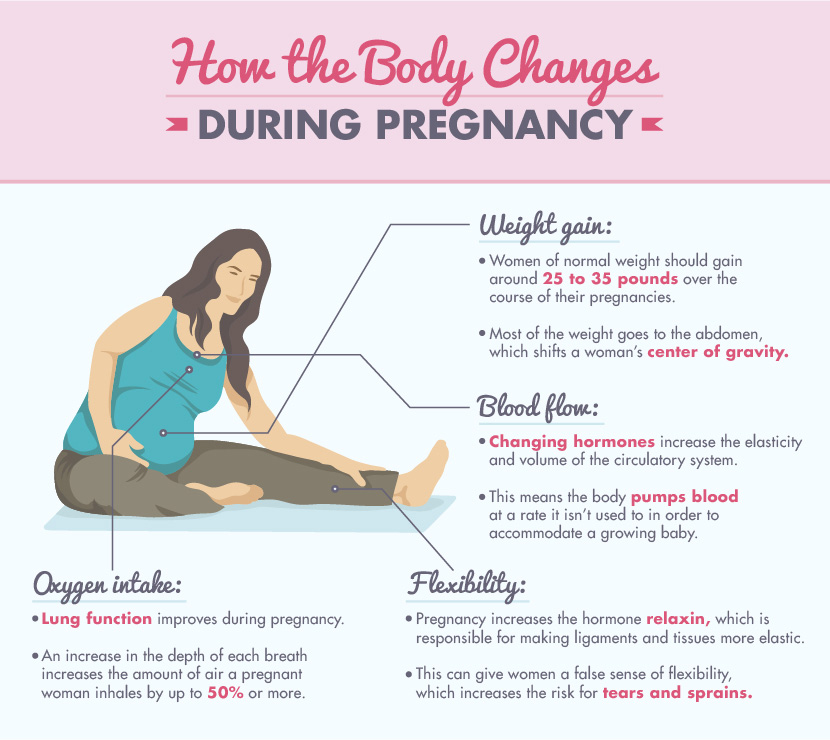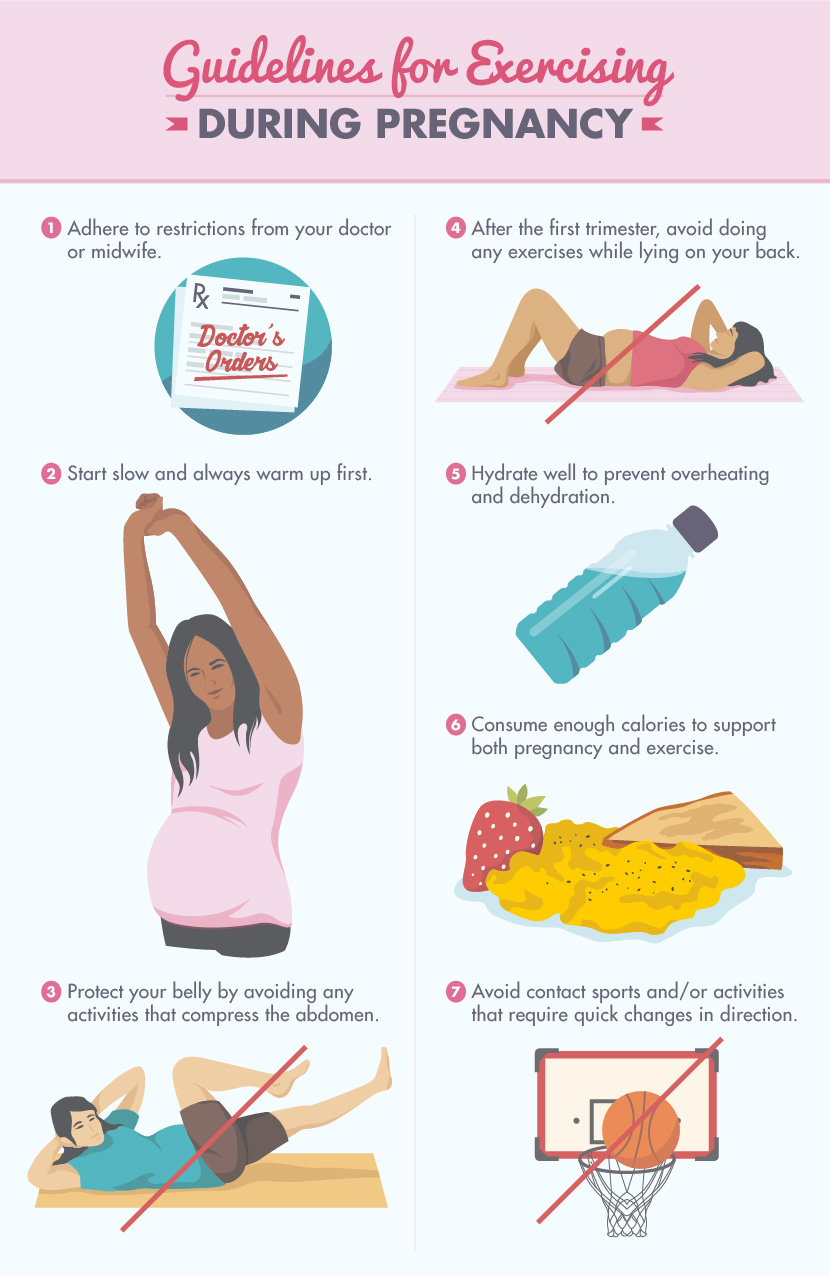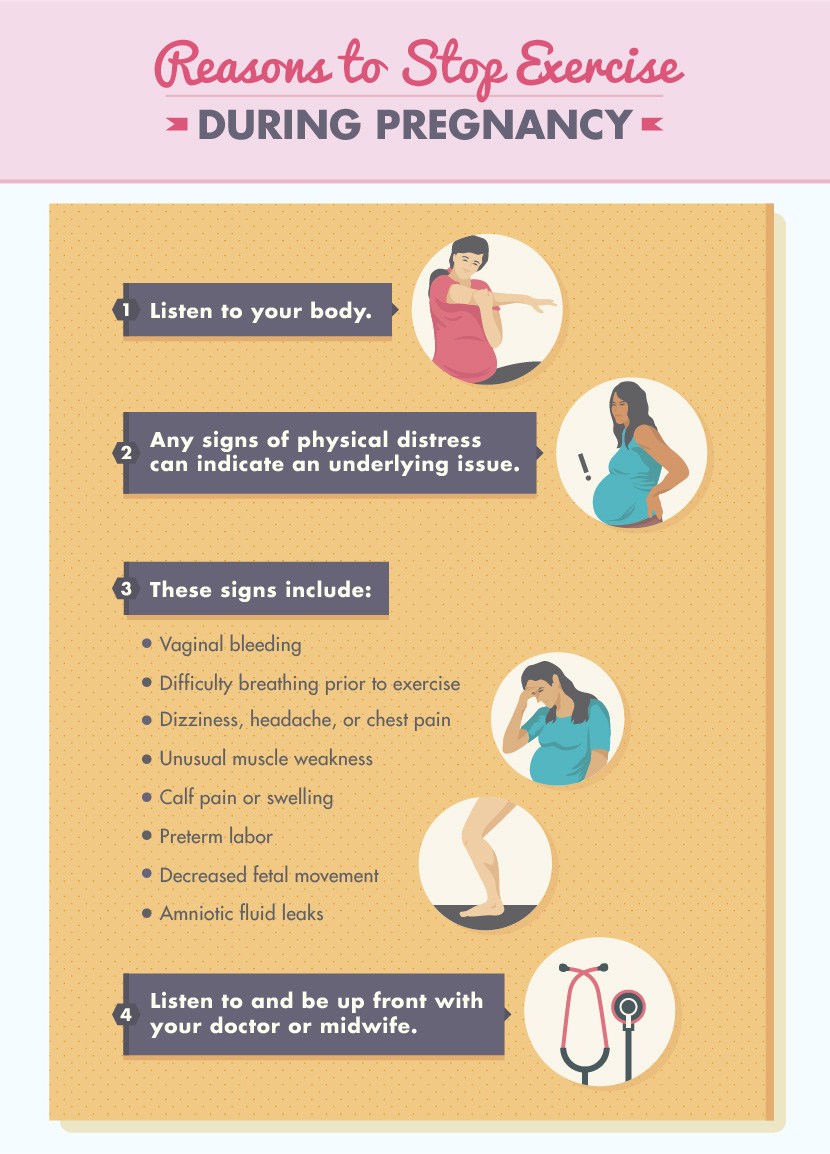Working Out for Two: How to Exercise Safely During Pregnancy
Congratulations! You’re pregnant, so now what? Must you sit still for nine months? Or can you keep working out? The answers: no and yes. Exercise during pregnancy is safe and often recommended.
Working out for two can be beneficial for Mom and baby; still, there are certain safety factors to consider.
How the Body Changes During Pregnancy

It’s no secret that a woman’s chest and abdomen grow as her baby gets bigger. But there are other underlying changes that take place, all of which can affect a woman’s
ability to exercise the way she may be used to. Here are a few.
Weight Gain: The American Congress of Obstetricians and Gynecologists (ACOG) recommends that women of normal weight gain 25 to 35 pounds over the course of their pregnancy.http://www.acog.org/Resources-And-Publications/Committee-Opinions/Committee-on-Obstetric-Practice/Weight-Gain-During-Pregnancy
Most of the weight goes directly to the abdomen, which creates a structural imbalance that shifts a woman’s center of gravity.
This puts new pressure on the joints as the body attempts to compensate. As a result, new aches and pains can develop.
Blood Flow: Changing hormones increase the elasticity and volume of the entire circulatory system.http://www.acefitness.org/blog/2639/what-you-need-to-know-about-pregnancy-and-exercise
Loosely translated: During pregnancy, the body pumps blood at a rate it isn’t used to in order to accommodate a growing baby.
Oxygen Intake: Lung function actually improves during pregnancy. At rest, an increase in the depth of each breath increases the amount of
air a pregnant woman inhales by up to 50 percent or more, which allows for increased oxygen uptake.
Flexibility: An increase in the hormone relaxin significantly affects physical activity. Relaxin is responsible for making ligaments
and tissues go soft and become more elastic.http://www.welcomebabyhome.com/pregnancy/pregnancy_harmones.htm This can give women a false sense of flexibility, which increases the risk of tears and sprains.
However, stretching while pregnant is important and can be done safely.http://tarasabo.blogspot.com/2014/04/workout-wednesday-5-prenatal-stretches.html
Despite these changes, exercise during pregnancy can be safe for both Mom and baby. Not only does it help maintain fitness,
but it can improve the body’s ability to cope with labor, delivery, and recovery.
The ACOG recommends at least 30 minutes of physical activity on most days of the week to reap these benefits.http://www.acog.org/Patients/FAQs/Exercise-During-Pregnancy
Benefits of Exercise During Pregnancy
- Exercise during any life stage can help minimize aches, pains, and general discomfort. With pregnancy, these discomforts may also include backache, constipation, bloating, swelling, and fatigue.
- Although genetics and age play a significant role in the risk of gestational diabetes, exercise can reduce this risk by as much as 27 percent.
- Exercise can help control weight gain, to a certain degree. A woman who stays within the recommended window of weight gain may also have a more comfortable
pregnancy, and may find it easier to lose weight once the baby is born.
- Endorphins, the hormones that make us feel happy and improve self-esteem, surge during exercise. http://www.webmd.com/depression/guide/exercise-depression
That means a workout can help a woman feel more confident about her growing, changing body and what it has to go through to bring a baby into this world.
These are just a few of the many benefits of exercising during pregnancy. As far as frequency and intensity, both differ from woman to woman.
Those who exercised regularly before conception should be able to maintain a similar level of fitness while working out for two. Pregnancy is not the time,
however, to set lofty physical goals or hold high expectations for personal records. Focus on maintenance and be ready to modify as pregnancy progresses.
But what if you haven’t been exercising regularly? It’s a common misconception that women who rarely work out shouldn’t introduce physical activity once they
become pregnant. Truth be told, it’s okay to start exercising, provided your doctor or midwife doesn’t object. Start slowly and at a lower intensity, with activities like walking or prenatal yoga.
Before starting or continuing any exercise program during pregnancy, consult a doctor or midwife. Health care professionals understand the
specifics of each woman’s pregnancy and can advise on appropriate levels of.
Guidelines for Exercise During Pregnancy

Historically, health care professionals suggested that pregnant women should limit their maximum heart rate to 140 beats per minute.http://www.mayoclinic.org/healthy-lifestyle/pregnancy-week-by-week/expert-answers/exercise-during-pregnancy/faq-20058359
These days, that recommendation doesn’t hold as much weight. Provided their pregnancy is healthy and normal, physically active women can
remain at a heart rate they are used to. As the body grows and changes, women may choose not to work out within their normal heart rate zones.
A comfortable working heart rate may change from day to day.
The effects of pregnancy on the body can and will slow a woman down. But this isn’t a bad thing. It’s the body’s way of adjusting.
The American Council on Exercise (ACE) suggests moving from heart rate-based training to ratings of perceived exertion.
The RPE scale is just as effective and less dependent on heart rate response, which changes during pregnancy because of increased cardiac output.http://www.acefitness.org/blog/2639/what-you-need-to-know-about-pregnancy-and-exercise
Ratings of perceived exertion are most often on a scale of 0 to 10. At 0, there is no effort.
At 10, activity is very, very hard or nearly impossible to sustain for any period of time.https://www.acefitness.org/fitfacts/pdfs/fitfacts/itemid_2579.pdf
Breathing, heart rate, and the way muscles and joints feel can help determine where an individual falls on the perceived exertion scale. This helps determine exercise intensity.
There are a number of safe options to consider when choosing an exercise routine, including swimming, yoga, walking, and strength training.
Even running during pregnancy is safe if you were a runner before conception, although speed and distance will most likely change. Qualified fitness professionals
can make modification recommendations to keep women moving as safely as possible. Never hesitate to ask for help.

Bottom line: a pregnant woman must listen to her body. If you recognize signs of distress, you should make modifications and contact your doctor or midwife.
It’s not about gaining muscle or running longer distances. It’s about maintenance, fighting fatigue, and adapting to the changes taking place inside and out.
Remember, every pregnancy is different. What works for one woman may not work for another, so find an activity that works for you and keep going. Your body and your baby will thank you.
Embed the article on your site

